Smoking Cigarette
13 likes4,211 views
Introduction Reasons why people Smoke Major Chemical Components of Cigarette Diseases Caused by Smoking Cigarette The Smokers Body
1 of 36
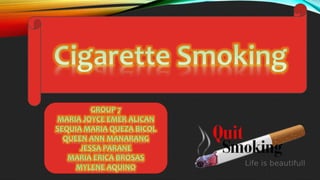



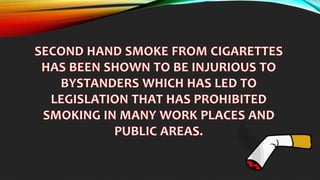
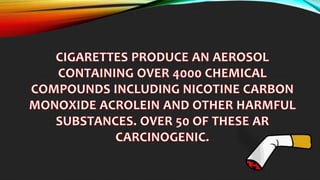
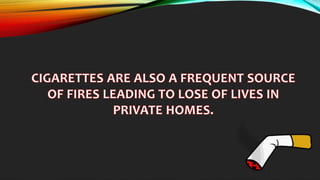
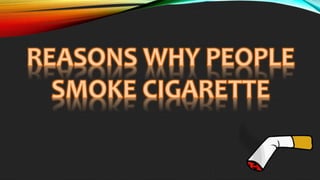
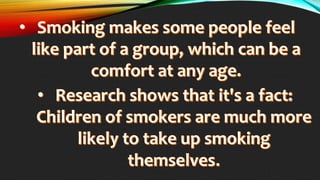
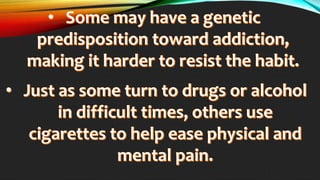


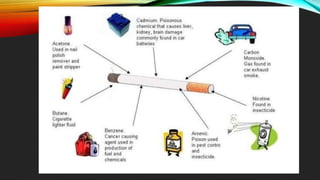
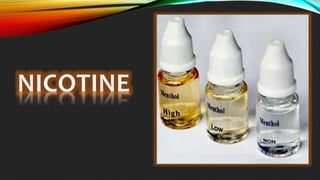
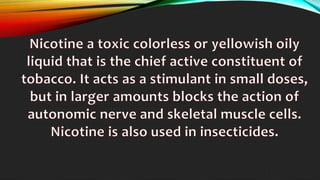


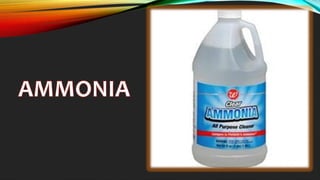


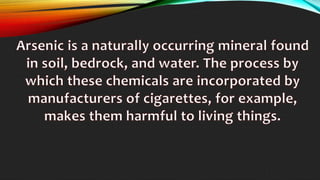
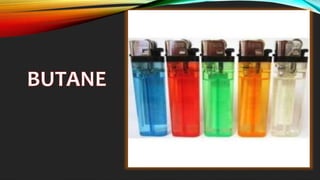

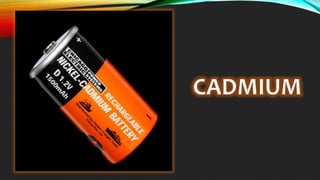



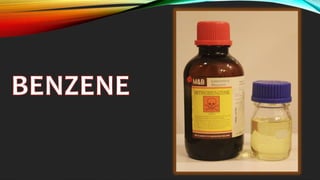

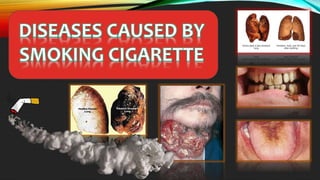
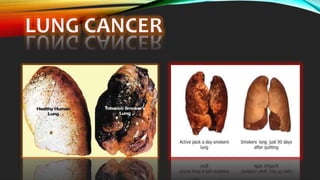
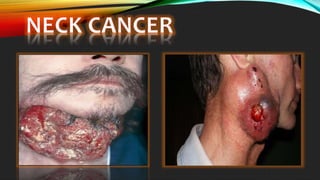
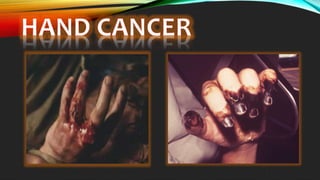

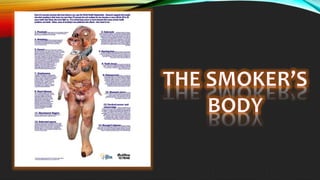

Ad
Recommended
Strategies in the Prevention and Control of Cigarette Smoking.pptx
Strategies in the Prevention and Control of Cigarette Smoking.pptxLea Sandra F. Banzon
╠²
The document outlines strategies for preventing and controlling cigarette smoking and alcohol consumption, emphasizing the importance of decision-making skills and resistance strategies. It includes activities for students to practice saying no, create advocacy materials, and engage in healthy alternatives to smoking and drinking. Objectives focus on personal responsibility, community involvement, and promoting a healthy lifestyle.Grade 7 - Diseases (Communicable and Non-communicable Diseases) part 2
Grade 7 - Diseases (Communicable and Non-communicable Diseases) part 2Jansen Jacinto
╠²
The document discusses four main types of non-communicable (chronic) diseases: cardiovascular diseases, cancer, chronic respiratory diseases, and diabetes. It provides details on the causes and symptoms of heart attacks, strokes, hypertension, tumors (benign vs. malignant), the four main categories of cancer, ways to treat cancer, and types of diabetes. Throughout, it emphasizes the importance of healthy behaviors like avoiding tobacco, exercising, eating nutritious foods, limiting sun exposure and alcohol, and getting regular medical checkups to help reduce the risk of these chronic diseases.Gateway Drugs 8.pptx
Gateway Drugs 8.pptxShielaMarieMariano1
╠²
Cigarettes and their smoke contain harmful chemicals and carcinogens that can negatively impact a person's health. Smoking cigarettes increases the risk of cancer and tobacco-related diseases. Nicotine is the addictive substance in cigarettes that increases central nervous system activity, which controls organs like the heart and lungs. There are three types of smoke produced by cigarettes: mainstream smoke inhaled by smokers, and sidestream and thirdhand smoke that can impact non-smokers. Laws in the Philippines regulate the sale and use of tobacco products to protect public health.THE DANGER OF CIGARETTE SMOKING- MAPEH HEALTH 4THQ.pptx
THE DANGER OF CIGARETTE SMOKING- MAPEH HEALTH 4THQ.pptxRejoicePlaza2
╠²
Cigarette smoking poses major health risks. It contains over 4,000 chemicals, including 43-60 known cancer-causing compounds and 400 toxins such as nicotine, tar, carbon monoxide, formaldehyde, ammonia, hydrogen cyanide, and arsenic. Nicotine is highly addictive and poisonous. According to studies, 2 out of 5 Filipino teenagers aged 13 to 15 smoke cigarettes, and 10 Filipinos die every hour from tobacco-related diseases. Cigarette smoke contains chemicals that can cause cancer, asthma, bronchitis, emphysema, pneumonia, and other serious illnesses.The Dangers of Alcohol - MAPEH 8 (Health 4th Quarter)
The Dangers of Alcohol - MAPEH 8 (Health 4th Quarter)Carlo Luna
╠²
The document discusses the dangers of alcohol consumption, outlining its types, effects on the body, and associated health risks. It explains that alcohol is a depressant that can impair physical and mental functions, leading to intoxication, hangovers, and long-term conditions like alcoholism and liver damage. Additionally, it describes the concept of blood-alcohol concentration (BAC) and the significance of understanding alcohol's impact on health.Philippine Folk Dances with Asian Influence - MAPEH 8 (P.E. 4th Quarter)
Philippine Folk Dances with Asian Influence - MAPEH 8 (P.E. 4th Quarter)Carlo Luna
╠²
The document discusses four Philippine folk dances with Asian influence: Binislakan, Sua-Ku-Sua, Pangalay, and Sakuting. It provides details on the meaning and origin of each dance, including the countries that influenced them. It describes the costumes, music, and movements involved in performing the dances. The dances originated from different regions in the Philippines and were influenced by countries like China, Malaysia, Indonesia, and others.DOH Presentation - Smoking
DOH Presentation - SmokingSmoke-Free Albay Network
╠²
This document discusses the global health issues caused by tobacco use. Some key points:
- Tobacco use killed 100 million people worldwide in the 20th century, and could kill 1 billion in the 21st century if trends continue.
- Tobacco use causes about 6 million deaths per year currently, and tobacco-related diseases account for about 10% of all deaths globally each year.
- Tobacco use results in an average of 15 years of life lost per smoker and costs nations about 3.6% of their GDP on average.
- 13,500 people die from tobacco use daily worldwide, more than from HIV/AIDS, tuberculosis, and malaria combined.Dangers of cigarette smoking
Dangers of cigarette smokingSarah Jane Pacamara
╠²
This document discusses the dangers of cigarette smoking. It notes that smoking is the second leading cause of death worldwide. It discusses the harmful effects of smoking on the skin, mouth, brain, lungs and heart. It provides strategies to prevent smoking, such as choosing non-smoking friends, staying busy and active, staying positive, and listening to advice from elders and parents. Students role play these prevention strategies and complete an assignment identifying three types of smoke produced by cigarettes.Drugs Substance Use and Abuse
Drugs Substance Use and AbuseAndrea Audine Jandongan
╠²
Substance use and abuse is commonly caused by ignorance or underestimating drugs' effects, especially addiction. Young people often start using drugs out of curiosity or to relieve stress. Drug education is important for prevention. Key factors influencing substance use include lack of parental supervision, peer pressure, feelings of pleasure, and relief from stress. Drugs are classified as substances that affect the body or mind and are intended for diagnosis, cure, treatment or prevention of disease. Prohibited drugs include opiates and hallucinogens, while regulated drugs are sedatives. Common classes of substances discussed are stimulants, depressants, inhalants, narcotics, and hallucinogens.Gateway Drugs - Risk and Protective Factors
Gateway Drugs - Risk and Protective FactorsJoshua Baluyot
╠²
The document discusses gateway drugs, which are legal drugs like cigarettes and alcohol that non-drug users may try and can lead to using more dangerous drugs like marijuana and methamphetamines. It notes that teenagers who smoke and drink at a young age are more likely to experiment with other drugs. The document provides questions and activities to help guide discussion around gateway drugs and their risks and health effects.Illegal drugs
Illegal drugsscott25gp
╠²
This document discusses different types of drugs and their effects. It begins by defining illegal drugs as drugs regulated by law that may be prescribed but are otherwise illegal to sell or use. It then discusses why illegal drug use is dangerous, noting risks of permanent brain and body damage, addiction, suicide, accidents, crime and disease transmission. Reasons people begin using drugs are also summarized as including experimentation, escaping problems, peer pressure and believing drugs solve issues. The stages of drug use are defined as regular use, tolerance, dependence and addiction. Finally, drugs that commonly lead to other drug use are listed as alcohol, tobacco and marijuana.Peking-opera - Mapeh grade 8 Q4
Peking-opera - Mapeh grade 8 Q4 John Michael Gian
╠²
Chinese opera has over 300 regional forms and is one of the oldest forms of theater in the world. Beijing opera is the most influential variety, featuring four main performance elements - singing, speech, dance-acting, and combat. Roles are strictly defined by color-coded masks and costumes, with the leading male role of Sheng and the main female role of Dan. Training is rigorous and starts at a young age, emphasizing skills like acrobatics. Beijing opera brings together music, mime, dance, and fighting styles into a continuous dramatic performance.Changes in different health dimensions during adolescence
Changes in different health dimensions during adolescenceER Baguinaon
╠²
Adolescence from ages 10 to 14 is a time of rapid physical, mental, emotional, and social development that varies widely among individuals. Physically, adolescents experience growth spurts, hormonal changes, and the development of secondary sex characteristics. Mentally, they develop more advanced abstract thinking abilities but may lack interest in academics. Emotionally, they experience mood swings, self-consciousness, and a desire for independence while establishing their identity. Their development is also influenced by gender, as girls begin menstruation and boys experience physical changes like growth of reproductive organs and body hair.Chemistry behineds firecrakers
Chemistry behineds firecrakersMayurMarvaniya1
╠²
Firecrackers are low explosive pyrotechnic devices used for aesthetic purposes, with origins traced back to ancient China over 2000 years ago. They consist of six vital ingredients: fuel, oxidizing agent, reducing agent, regulator, binder, and coloring agents, with health and environmental concerns due to air and noise pollution. The release of harmful chemicals from firecrackers can negatively impact respiratory and nervous systems, as well as cause significant noise disturbance.Grade 7 - Diseases (Communicable and Non-communicable Diseases) part 1
Grade 7 - Diseases (Communicable and Non-communicable Diseases) part 1Jansen Jacinto
╠²
This document discusses communicable and noncommunicable diseases. It defines communicable diseases as illnesses that can be passed from person to person caused by germs like bacteria, viruses, fungi and protozoa. Examples provided are colds, pneumonia, influenza, mononucleosis and malaria. Noncommunicable diseases are described as chronic conditions like cardiovascular disease, cancer, diabetes and chronic respiratory diseases. Risk factors discussed include unhealthy diet, tobacco use, physical inactivity, obesity and genetics. The document states that these noncommunicable diseases are the top killers worldwide and in the Philippines, and that many deaths from them occur prematurely.types of drug use & different drug effects
types of drug use & different drug effectsChaitanya Limbachiya
╠²
This document discusses different types of drug use and their effects. It defines drugs and outlines five common methods of drug use: ingestion, absorption, smoking, inhalation, and injection. Each method is described in terms of how the drug enters the body. The document also discusses short and long-term physical, neurological, emotional, legal, social, and adolescent consequences of drug abuse. These include organ damage, memory loss, fines, job loss, suicide and more. In summary, the document provides definitions of drugs and outlines various methods of drug use and wide-ranging effects.MAPEH 9 - Health - Drugs of Abuse (The Six Classifications of Drugs of Abuse)...
MAPEH 9 - Health - Drugs of Abuse (The Six Classifications of Drugs of Abuse)...Talangan Integrated National High School
╠²
This document outlines the six classifications of drugs of abuse:
1. Gateway drugs include legal drugs like tobacco and alcohol that can lead to use of more dangerous drugs.
2. Depressant drugs slow the central nervous system and include alcohol, barbiturates, and tranquilizers. They are sometimes prescribed to treat conditions like anxiety.
3. Stimulant drugs speed up the central nervous system and include amphetamines, caffeine, nicotine, cocaine, and methamphetamine. They provide energy but can cause depression and tiredness.
4. Narcotics relieve pain and induce sleep and include opioids like heroin and marijuana. They are sometimes prescribed for pain but are also abused recreationally.Chinese Theater - MAPEH 8 (Music 4th Quarter)
Chinese Theater - MAPEH 8 (Music 4th Quarter)Carlo Luna
╠²
Chinese theater, traditionally considered the highest art form in China, includes Peking Opera. Peking Opera is a stylized form of opera that developed in Beijing in the late 18th century combining speech, singing, mime, and acrobatics accompanied by various instruments. It features two main musical styles - Erh-huang and His-p'l - and strict conventions for vocal delivery and rhythmic spoken passages. The orchestra typically includes 8 musicians playing instruments like flutes, trumpets, violins, lutes, guitars, drums and gongs to accompany the performers and signify the beginning and tempo of the performance. Peking Opera remains an important part of China's cultural heritage.Gateway drugs
Gateway drugsSarah Jane Pacamara
╠²
Gateway drugs are substances like cigarettes and alcohol that are legal and widely accepted but can increase a person's risk of using illegal drugs. Cigarettes and alcohol are considered gateway drugs because they are readily available and socially acceptable, leading many people to use them and potentially progress to harder substances. Studies show that a large portion of Filipino teenagers have smoked cigarettes and tobacco-related deaths in the Philippines remain high, indicating that prevention efforts are needed, especially for curious and risk-taking youth.Anti-smoking Powerpoint - Aquino,Salinas,Santos,Soledad
Anti-smoking Powerpoint - Aquino,Salinas,Santos,SoledadJoanne Santos
╠²
The document contains statistics and information about smoking in the Philippines. It discusses the estimated number of Filipinos who smoke daily and the average number of cigarettes smoked. It also mentions the percentage of lung cancer deaths worldwide attributed to tobacco and the estimated number of Filipinos who die daily from smoke-related illnesses. The document then covers the history of cigarettes and addictive properties of nicotine. It outlines health effects like heart disease and strokes as well as environmental impacts before providing tips on how to quit smoking.Smoking
SmokingV─Śj┼½na Nostalgia
╠²
The document outlines the historical and cultural significance of tobacco and hallucinogenic drug smoking across different regions, from ancient times to modernity, highlighting the spread of tobacco use globally following European colonization. It details the health risks associated with smoking, including various cancers and heart diseases, emphasizing smoking as a major cause of preventable death. The text also addresses smoking trends in Lithuania, including laws regulating tobacco use, and discusses anti-smoking initiatives within the European Union.DOH Presentation Smoking and your Health
DOH Presentation Smoking and your HealthSmoke-Free Albay Network
╠²
The document discusses the health hazards of smoking and tobacco use in the Philippines. It provides statistics showing that 240 Filipinos die daily from tobacco-related diseases. Nearly half of adult males (47.7%) smoke, compared to 9% of adult females. Over 20% of students currently smoke cigarettes. The main toxic components of tobacco smoke - nicotine, tar, and carbon monoxide - are explained. Smoking is linked to numerous forms of cancer, heart disease, strokes, lung disease, and other health problems. The document urges youth not to start smoking and encourages stopping to save lives.Smoking
Smokingeman fathi
╠²
Tobacco use is a major public health problem that kills over 5 million people worldwide each year. In Sudan, smoking prevalence among males is around 24% compared to only 2% among females. There are effective tobacco control strategies available through the WHO Framework Convention on Tobacco Control (FCTC) including tax increases, advertising bans, smoke-free laws, health warnings on packages, and cessation support. Quitting tobacco has significant health, economic, and social benefits for individuals and their families.Health Education 7 1st Quarter Lesson 2 stages of growth and development
Health Education 7 1st Quarter Lesson 2 stages of growth and developmentElaine Maspinas
╠²
The document discusses human development and health. It describes human development as a lifelong process of physical, mental, emotional, social, moral-spiritual, and environmental growth and change. It then outlines 8 stages of psychological development from infancy to older adulthood, describing the key developmental tasks associated with each stage. The document also provides a 10-item quiz on dimensions of health, including physical, mental, emotional, social, environmental, and moral-spiritual health.1. Music of Cordillera.pptx
1. Music of Cordillera.pptxanami87
╠²
The document discusses the music of the Cordillera region of the Philippines. It describes various vocal and instrumental music styles of different ethnic groups in Cordillera. It provides details on indigenous instruments commonly used in the region such as gongs, bamboo flutes, nose flutes, jaw harps and bamboo tubes. It also lists different song genres associated with life events like infancy, marriage and entertainment.Presentation1 smoking
Presentation1 smokingamercjj
╠²
The document discusses smoking and its consequences. It defines smoking as inhaling the smoke of burned substances like tobacco. It then lists some common reasons why people smoke, such as following the behaviors of parents/friends or managing stress. The document outlines several potential symptoms of smoking, including bad breath, discolored teeth/fingers, and various respiratory issues. It also discusses some serious health consequences of smoking like various cancers, emphysema, and strokes. The document concludes by providing some tips for quitting smoking and sharing smoking statistics.Music of the Cordilleras
Music of the CordillerasCharlene Mangaldan
╠²
The Cordilleras region of the Philippines has a rich traditional music culture. Music is an integral part of daily life and important community and religious activities. Each ethnic group has its own distinctive vocal and instrumental styles. Songs are commonly performed in groups and feature pentatonic melodies. Important genres include narrative chants, folk songs, and music to accompany rituals, festivities, and life events. Traditional instruments are made of bamboo and metal and include gangsa gongs, bamboo flutes, nose flutes, xylophones, and drums. Ensemble music features interlocking rhythmic patterns played on differently pitched instruments. Traditional music is an important part of cultural heritage passed down through oral tradition.Ibong adarna
Ibong adarnaAncel Lopez
╠²
Don Juan is sent on a quest to find the magical Ibong Adarna bird to cure his ailing father, the King. He succeeds where his two older brothers failed, avoiding their fate of being turned to stone. After many adventures, including rescuing princesses from dangers in an underground world accessed via a deep well, Don Juan continues his journey to find the kingdom of Delos Cristal and the beautiful princess said to be even lovelier than his love interest, Princess Leonora. He seeks information from increasingly older hermits, the latest being 800 years old, who he hopes can provide directions to the elusive kingdom.Ibong Adarna (Kabanata 1-3)
Ibong Adarna (Kabanata 1-3)SCPS
╠²
Ang kwento ng Ibong Adarna ay nagsimula sa pamamagitan ng panalangin ng manunulat kay Birheng Maria upang magkaroon ng inspirasyon sa kanyang akda. Sa Berbanya, si Haring Fernando at ang kanyang maganda at mabait na asawa, si Donya Valeriana, ay may tatlong anak na sina Don Pedro, Don Diego, at Don Juan. Sa gitna ng masamang panaginip ng hari na nagdulot ng kanyang sakit, iniutos niya kay Don Pedro na kunin ang Ibong Adarna mula sa Bundok Tabor upang magamot ang kanyang karamdaman.More Related Content
What's hot (20)
Drugs Substance Use and Abuse
Drugs Substance Use and AbuseAndrea Audine Jandongan
╠²
Substance use and abuse is commonly caused by ignorance or underestimating drugs' effects, especially addiction. Young people often start using drugs out of curiosity or to relieve stress. Drug education is important for prevention. Key factors influencing substance use include lack of parental supervision, peer pressure, feelings of pleasure, and relief from stress. Drugs are classified as substances that affect the body or mind and are intended for diagnosis, cure, treatment or prevention of disease. Prohibited drugs include opiates and hallucinogens, while regulated drugs are sedatives. Common classes of substances discussed are stimulants, depressants, inhalants, narcotics, and hallucinogens.Gateway Drugs - Risk and Protective Factors
Gateway Drugs - Risk and Protective FactorsJoshua Baluyot
╠²
The document discusses gateway drugs, which are legal drugs like cigarettes and alcohol that non-drug users may try and can lead to using more dangerous drugs like marijuana and methamphetamines. It notes that teenagers who smoke and drink at a young age are more likely to experiment with other drugs. The document provides questions and activities to help guide discussion around gateway drugs and their risks and health effects.Illegal drugs
Illegal drugsscott25gp
╠²
This document discusses different types of drugs and their effects. It begins by defining illegal drugs as drugs regulated by law that may be prescribed but are otherwise illegal to sell or use. It then discusses why illegal drug use is dangerous, noting risks of permanent brain and body damage, addiction, suicide, accidents, crime and disease transmission. Reasons people begin using drugs are also summarized as including experimentation, escaping problems, peer pressure and believing drugs solve issues. The stages of drug use are defined as regular use, tolerance, dependence and addiction. Finally, drugs that commonly lead to other drug use are listed as alcohol, tobacco and marijuana.Peking-opera - Mapeh grade 8 Q4
Peking-opera - Mapeh grade 8 Q4 John Michael Gian
╠²
Chinese opera has over 300 regional forms and is one of the oldest forms of theater in the world. Beijing opera is the most influential variety, featuring four main performance elements - singing, speech, dance-acting, and combat. Roles are strictly defined by color-coded masks and costumes, with the leading male role of Sheng and the main female role of Dan. Training is rigorous and starts at a young age, emphasizing skills like acrobatics. Beijing opera brings together music, mime, dance, and fighting styles into a continuous dramatic performance.Changes in different health dimensions during adolescence
Changes in different health dimensions during adolescenceER Baguinaon
╠²
Adolescence from ages 10 to 14 is a time of rapid physical, mental, emotional, and social development that varies widely among individuals. Physically, adolescents experience growth spurts, hormonal changes, and the development of secondary sex characteristics. Mentally, they develop more advanced abstract thinking abilities but may lack interest in academics. Emotionally, they experience mood swings, self-consciousness, and a desire for independence while establishing their identity. Their development is also influenced by gender, as girls begin menstruation and boys experience physical changes like growth of reproductive organs and body hair.Chemistry behineds firecrakers
Chemistry behineds firecrakersMayurMarvaniya1
╠²
Firecrackers are low explosive pyrotechnic devices used for aesthetic purposes, with origins traced back to ancient China over 2000 years ago. They consist of six vital ingredients: fuel, oxidizing agent, reducing agent, regulator, binder, and coloring agents, with health and environmental concerns due to air and noise pollution. The release of harmful chemicals from firecrackers can negatively impact respiratory and nervous systems, as well as cause significant noise disturbance.Grade 7 - Diseases (Communicable and Non-communicable Diseases) part 1
Grade 7 - Diseases (Communicable and Non-communicable Diseases) part 1Jansen Jacinto
╠²
This document discusses communicable and noncommunicable diseases. It defines communicable diseases as illnesses that can be passed from person to person caused by germs like bacteria, viruses, fungi and protozoa. Examples provided are colds, pneumonia, influenza, mononucleosis and malaria. Noncommunicable diseases are described as chronic conditions like cardiovascular disease, cancer, diabetes and chronic respiratory diseases. Risk factors discussed include unhealthy diet, tobacco use, physical inactivity, obesity and genetics. The document states that these noncommunicable diseases are the top killers worldwide and in the Philippines, and that many deaths from them occur prematurely.types of drug use & different drug effects
types of drug use & different drug effectsChaitanya Limbachiya
╠²
This document discusses different types of drug use and their effects. It defines drugs and outlines five common methods of drug use: ingestion, absorption, smoking, inhalation, and injection. Each method is described in terms of how the drug enters the body. The document also discusses short and long-term physical, neurological, emotional, legal, social, and adolescent consequences of drug abuse. These include organ damage, memory loss, fines, job loss, suicide and more. In summary, the document provides definitions of drugs and outlines various methods of drug use and wide-ranging effects.MAPEH 9 - Health - Drugs of Abuse (The Six Classifications of Drugs of Abuse)...
MAPEH 9 - Health - Drugs of Abuse (The Six Classifications of Drugs of Abuse)...Talangan Integrated National High School
╠²
This document outlines the six classifications of drugs of abuse:
1. Gateway drugs include legal drugs like tobacco and alcohol that can lead to use of more dangerous drugs.
2. Depressant drugs slow the central nervous system and include alcohol, barbiturates, and tranquilizers. They are sometimes prescribed to treat conditions like anxiety.
3. Stimulant drugs speed up the central nervous system and include amphetamines, caffeine, nicotine, cocaine, and methamphetamine. They provide energy but can cause depression and tiredness.
4. Narcotics relieve pain and induce sleep and include opioids like heroin and marijuana. They are sometimes prescribed for pain but are also abused recreationally.Chinese Theater - MAPEH 8 (Music 4th Quarter)
Chinese Theater - MAPEH 8 (Music 4th Quarter)Carlo Luna
╠²
Chinese theater, traditionally considered the highest art form in China, includes Peking Opera. Peking Opera is a stylized form of opera that developed in Beijing in the late 18th century combining speech, singing, mime, and acrobatics accompanied by various instruments. It features two main musical styles - Erh-huang and His-p'l - and strict conventions for vocal delivery and rhythmic spoken passages. The orchestra typically includes 8 musicians playing instruments like flutes, trumpets, violins, lutes, guitars, drums and gongs to accompany the performers and signify the beginning and tempo of the performance. Peking Opera remains an important part of China's cultural heritage.Gateway drugs
Gateway drugsSarah Jane Pacamara
╠²
Gateway drugs are substances like cigarettes and alcohol that are legal and widely accepted but can increase a person's risk of using illegal drugs. Cigarettes and alcohol are considered gateway drugs because they are readily available and socially acceptable, leading many people to use them and potentially progress to harder substances. Studies show that a large portion of Filipino teenagers have smoked cigarettes and tobacco-related deaths in the Philippines remain high, indicating that prevention efforts are needed, especially for curious and risk-taking youth.Anti-smoking Powerpoint - Aquino,Salinas,Santos,Soledad
Anti-smoking Powerpoint - Aquino,Salinas,Santos,SoledadJoanne Santos
╠²
The document contains statistics and information about smoking in the Philippines. It discusses the estimated number of Filipinos who smoke daily and the average number of cigarettes smoked. It also mentions the percentage of lung cancer deaths worldwide attributed to tobacco and the estimated number of Filipinos who die daily from smoke-related illnesses. The document then covers the history of cigarettes and addictive properties of nicotine. It outlines health effects like heart disease and strokes as well as environmental impacts before providing tips on how to quit smoking.Smoking
SmokingV─Śj┼½na Nostalgia
╠²
The document outlines the historical and cultural significance of tobacco and hallucinogenic drug smoking across different regions, from ancient times to modernity, highlighting the spread of tobacco use globally following European colonization. It details the health risks associated with smoking, including various cancers and heart diseases, emphasizing smoking as a major cause of preventable death. The text also addresses smoking trends in Lithuania, including laws regulating tobacco use, and discusses anti-smoking initiatives within the European Union.DOH Presentation Smoking and your Health
DOH Presentation Smoking and your HealthSmoke-Free Albay Network
╠²
The document discusses the health hazards of smoking and tobacco use in the Philippines. It provides statistics showing that 240 Filipinos die daily from tobacco-related diseases. Nearly half of adult males (47.7%) smoke, compared to 9% of adult females. Over 20% of students currently smoke cigarettes. The main toxic components of tobacco smoke - nicotine, tar, and carbon monoxide - are explained. Smoking is linked to numerous forms of cancer, heart disease, strokes, lung disease, and other health problems. The document urges youth not to start smoking and encourages stopping to save lives.Smoking
Smokingeman fathi
╠²
Tobacco use is a major public health problem that kills over 5 million people worldwide each year. In Sudan, smoking prevalence among males is around 24% compared to only 2% among females. There are effective tobacco control strategies available through the WHO Framework Convention on Tobacco Control (FCTC) including tax increases, advertising bans, smoke-free laws, health warnings on packages, and cessation support. Quitting tobacco has significant health, economic, and social benefits for individuals and their families.Health Education 7 1st Quarter Lesson 2 stages of growth and development
Health Education 7 1st Quarter Lesson 2 stages of growth and developmentElaine Maspinas
╠²
The document discusses human development and health. It describes human development as a lifelong process of physical, mental, emotional, social, moral-spiritual, and environmental growth and change. It then outlines 8 stages of psychological development from infancy to older adulthood, describing the key developmental tasks associated with each stage. The document also provides a 10-item quiz on dimensions of health, including physical, mental, emotional, social, environmental, and moral-spiritual health.1. Music of Cordillera.pptx
1. Music of Cordillera.pptxanami87
╠²
The document discusses the music of the Cordillera region of the Philippines. It describes various vocal and instrumental music styles of different ethnic groups in Cordillera. It provides details on indigenous instruments commonly used in the region such as gongs, bamboo flutes, nose flutes, jaw harps and bamboo tubes. It also lists different song genres associated with life events like infancy, marriage and entertainment.Presentation1 smoking
Presentation1 smokingamercjj
╠²
The document discusses smoking and its consequences. It defines smoking as inhaling the smoke of burned substances like tobacco. It then lists some common reasons why people smoke, such as following the behaviors of parents/friends or managing stress. The document outlines several potential symptoms of smoking, including bad breath, discolored teeth/fingers, and various respiratory issues. It also discusses some serious health consequences of smoking like various cancers, emphysema, and strokes. The document concludes by providing some tips for quitting smoking and sharing smoking statistics.Music of the Cordilleras
Music of the CordillerasCharlene Mangaldan
╠²
The Cordilleras region of the Philippines has a rich traditional music culture. Music is an integral part of daily life and important community and religious activities. Each ethnic group has its own distinctive vocal and instrumental styles. Songs are commonly performed in groups and feature pentatonic melodies. Important genres include narrative chants, folk songs, and music to accompany rituals, festivities, and life events. Traditional instruments are made of bamboo and metal and include gangsa gongs, bamboo flutes, nose flutes, xylophones, and drums. Ensemble music features interlocking rhythmic patterns played on differently pitched instruments. Traditional music is an important part of cultural heritage passed down through oral tradition.MAPEH 9 - Health - Drugs of Abuse (The Six Classifications of Drugs of Abuse)...
MAPEH 9 - Health - Drugs of Abuse (The Six Classifications of Drugs of Abuse)...Talangan Integrated National High School
╠²
Viewers also liked (7)
Ibong adarna
Ibong adarnaAncel Lopez
╠²
Don Juan is sent on a quest to find the magical Ibong Adarna bird to cure his ailing father, the King. He succeeds where his two older brothers failed, avoiding their fate of being turned to stone. After many adventures, including rescuing princesses from dangers in an underground world accessed via a deep well, Don Juan continues his journey to find the kingdom of Delos Cristal and the beautiful princess said to be even lovelier than his love interest, Princess Leonora. He seeks information from increasingly older hermits, the latest being 800 years old, who he hopes can provide directions to the elusive kingdom.Ibong Adarna (Kabanata 1-3)
Ibong Adarna (Kabanata 1-3)SCPS
╠²
Ang kwento ng Ibong Adarna ay nagsimula sa pamamagitan ng panalangin ng manunulat kay Birheng Maria upang magkaroon ng inspirasyon sa kanyang akda. Sa Berbanya, si Haring Fernando at ang kanyang maganda at mabait na asawa, si Donya Valeriana, ay may tatlong anak na sina Don Pedro, Don Diego, at Don Juan. Sa gitna ng masamang panaginip ng hari na nagdulot ng kanyang sakit, iniutos niya kay Don Pedro na kunin ang Ibong Adarna mula sa Bundok Tabor upang magamot ang kanyang karamdaman.Cigarette smoking
Cigarette smokingSabbir78692
╠²
Smoking involves inhaling smoke from burned tobacco in cigarettes, cigars, or pipes. Cigarette smoke contains over 4,000 chemicals including 60 known carcinogens such as nicotine, tar, carbon monoxide, benzene, and formaldehyde. Smoking is highly addictive and can cause serious health issues like lung cancer, emphysema, heart disease, and premature death. While people may smoke for relaxation or social reasons, quitting can improve health, save money, and prevent disease.The Impact of Advertising on Cigarette Smoking
The Impact of Advertising on Cigarette Smokingacumming
╠²
The document lists various online resources related to tobacco, smoking advertisements, and anti-smoking campaigns. It includes links to articles, studies, and historical information about smoking and its societal impacts. Additionally, it mentions a ban on local cigarette sales in Bhutan and highlights various sources discussing smoking-related topics.Cigarette smoking and itŌĆÖs ill effects
Cigarette smoking and itŌĆÖs ill effectsHardik Maini
╠²
This document summarizes the negative health effects of cigarette smoking. It notes that over 80,000 adolescents start smoking every day, and that every 8 seconds someone dies from tobacco use. The document outlines several serious health risks of smoking such as increased risk of stroke, suppression of the immune system, addiction, high blood pressure, gum disease, emphysema, cancer, reduced stamina, depression and fatigue. It also discusses how smoking damages the lungs and skin. The document aims to educate people on the dangers of smoking and encourage smokers to quit.Smoking & periodontium
Smoking & periodontiumThiripurasundari Arumugam
╠²
Smoking has significant negative effects on periodontal health and outcomes of periodontal therapy. According to the document, smoking is a major risk factor for periodontitis, with smokers being 2-4 times more likely to develop periodontitis than non-smokers. Smoking reduces blood flow and oxygen to the gingiva, inhibits immune response, increases periodontal pathogens, and reduces fibroblast function, all of which promote periodontal disease and make treatment more challenging. The document examines in detail the epidemiological evidence linking smoking to periodontal disease as well as the mechanisms by which smoking damages periodontal tissues.Climate zones and climate changes (2)
Climate zones and climate changes (2)Faizan5
╠²
This document discusses climate zones and climate change. It begins with an introduction to climate and what climate zones are. It then discusses several classification systems for climate zones, including K├Čppen climate zones. It also discusses factors that affect climate in different zones, such as latitude, large bodies of water, air currents, land formations, and altitude. The document concludes with a section on the balance of energy on Earth.Ad
Recently uploaded (20)
Disability Support Services Melbourne - Comfort Support Care
Disability Support Services Melbourne - Comfort Support CareNDISProviderMelbourn
╠²
Comfort Support Care offers personalised Disability Support Services in Melbourne, helping individuals live more independently and with dignity. From daily personal care to community participation, our friendly support workers are here to assist. We focus on your goals, well-being, and NDIS plan needs, ensuring consistent and compassionate care every day.
Burns types and its management .pptx
Burns types and its management .pptxRishika Rawat
╠²
Damage to the skin or deeper tissues caused by sun, hot liquids, fire, electricity or chemicals.
Most burns happen accidentally. The degree of severity of most burns is based on the size and depth of the burn. Electrical burns, however, are more difficult to diagnose because they're capable of causing significant injury beneath the skin without showing any signs of damage on the surface.Medivic Ambulance Operates Carefully to Reduce the Hurdle on Patients in Patn...
Medivic Ambulance Operates Carefully to Reduce the Hurdle on Patients in Patn...Medivic Aviation Air and Train AMbulance Services in Guwahati
╠²
Medivic Train Ambulance Service in Patna and Ranchi understands the nervousness of families and strives to reduce this through professional management and constant monitoring. We're prepared for every medical emergency and provide dedicated, convenient assistance at all times.
Web@: https://tinyurl.com/2jh9wpdu
More@: https://tinyurl.com/n9dt3vn7
Public-Private Partnerships in Healthcare_ A Sustainable Model for African Na...
Public-Private Partnerships in Healthcare_ A Sustainable Model for African Na...oliverwanyama96
╠²
Across Africa, healthcare systems are under increasing pressure from rising populations, chronic underfunding, and infrastructure gaps that limit access to quality care. In response, Public-Private Partnerships (PPPs) are gaining momentum as a sustainable model to deliver healthcare infrastructure, services, and innovation.
Dengue Basic Information_Mitigation & Response_Dr. Pankaj Singh
Dengue Basic Information_Mitigation & Response_Dr. Pankaj Singhpanpunpra
╠²
Dengue Basic Information_Mitigation & Response_Dr. Pankaj SinghDr. James Farley Focuses on Better Health Outcomes for Every Patient
Dr. James Farley Focuses on Better Health Outcomes for Every PatientDrJamesFarley
╠²
Discover how Dr. James Farley delivers better health outcomes through his Neuro-BioMedicine Health System. With over 25,000 treatments performed, Dr. Farley specializes in chronic conditions, addiction recovery, and brain health using a science-based, patient-first approachWhat is Medical Billing, and How does it Work.pdf
What is Medical Billing, and How does it Work.pdfDevinclark22
╠²
Medical billing is the process of verifying insurance, coding procedures accurately, submitting claims, and following up on delayed payments
Reliable Ambulance Services Saving Lives Across Cities.pdf
Reliable Ambulance Services Saving Lives Across Cities.pdfAmbulance services in delhi
╠²
Experience fast and dependable ambulance services in Prayagraj, designed to provide critical medical support during emergencies. Our well-equipped ambulances and skilled paramedics ensure safe and comfortable patient transport, available round-the-clock to assist you whenever needed. Trust us for professional and compassionate care every step of the way.Quality in Health Care including Quality assurance, control & improvement
Quality in Health Care including Quality assurance, control & improvementAll India Institute of Medical Sciences, Patna
╠²
Quality in Health CareCongenital Vertical Talus: Clinical Presentation, Imaging, Etiology, and Mult...
Congenital Vertical Talus: Clinical Presentation, Imaging, Etiology, and Mult...Dr. Prabhat Pandey
╠²
Congenital Vertical Talus (CVT)ŌĆöalso known as Congenital Convex Pes Valgus or Teratologic Dorsolateral Dislocation of the Talocalcaneonavicular JointŌĆöis a rare but significant pediatric foot deformity, characterized by a fixed dorsal dislocation of the talonavicular joint and rigid hindfoot equinus. This unique anatomical disruption gives rise to the hallmark "rocker-bottom" deformity, often evident at birth.
In this comprehensive presentation by Dr. Prabhat Pandey, DNB Orthopedics Resident at Tata Main Hospital, we explore every crucial aspect of Congenital Vertical TalusŌĆöfrom its pathoanatomy and etiology to detailed clinical assessment and advanced management strategies. This ║▌║▌▀ŻShare is tailored for orthopedic surgeons, pediatricians, medical students, and physiotherapists engaged in pediatric musculoskeletal care.
Congenital Vertical Talus is rare, rigid, and complex
Must distinguish from positional deformities like calcaneovalgus foot
Accurate radiographic analysis is essential for diagnosis
Reverse Ponseti casting can reduce need for extensive surgery
Surgical release is often definitive but must be timed and tailored
Multidisciplinary management is crucial in syndromic casesImproving access to appropriately fitted equipment to support mothers express...
Improving access to appropriately fitted equipment to support mothers express...Health Innovation Wessex
╠²
The document outlines a project toolkit created by Health Innovation Wessex to improve access to properly fitted equipment for mothers expressing breast milk, aimed at promoting better health outcomes for premature infants. It includes two sections: the first discussing the project's background and evidence, while the second provides resources and training materials for implementation in healthcare settings. The initiative is based on research indicating that correctly sized flanges can enhance milk yield and reduce discomfort, ultimately supporting maternal and infant health.
The original toolkit was published in January 2025. Version 2, published June 2025, contains further information about flange sizing and kits available. VoyageHealing- ketamine and wellness clinic.pdf
VoyageHealing- ketamine and wellness clinic.pdfVoyage Healing
╠²
A Compassionate Ketamine and Wellness Clinic.
At Voyage, we are reimagining mental health treatment offering talk therapy, medication management, and novel tools like ketamine therapy and Spravato.
FSc MLT Federal Board | Unsolved Past Paper ŌĆō Elementary Anatomy & Microtechn...
FSc MLT Federal Board | Unsolved Past Paper ŌĆō Elementary Anatomy & Microtechn...azkaimran130
╠²
¤ōÜ FSc MLT Federal Board | Unsolved Past Paper ŌĆō Elementary Anatomy & Microtechnique
Welcome to our Medical Lab Technology (MLT) channel!
In this video, weŌĆÖre sharing an unsolved past paper of Elementary Anatomy and Microtechnique for FSc MLT (1nd Year) students under the Federal Board curriculum. This paper is perfect for self-assessment, practice, and preparation for upcoming exams.
¤Ä» What YouŌĆÖll Get:
Unsolved past paper questions
Ideal for practice and revision
Based on the Federal Board exam pattern
Useful for 1st-year MLT, cardiac tech, OTT students
¤ōī DonŌĆÖt forget to:
Ō£ģ Like the video
Ō£ģ Subscribe for more MLT content
Ō£ģ Comment your questions
Ō£ģ Share with classmatesA Research Synopsis Presentation on Breast Cancer
A Research Synopsis Presentation on Breast CancerAvantika Gupta
╠²
ABSTRACT
ŌĆ£A Quasi experimental study to assess the effectiveness of structured teaching programe on knowledge regarding Breast Cancer among selected students of Rajkiya Kanya Mahavidyalaya College, Shimla, Himachal Pradesh.ŌĆØ
Introduction: - Breast cancer is one of the most common Second types of cancer in India. In 2024, the estimated number of Breast cancer cases in Himachal Pradesh is 9,566. Breast Cancer is the second most common cancer among women in Himachal Pradesh also. The Indira Gandhi Medical College (IGMC) in Shimla reports an estimated 220 and 250 new Breast Cancer cases each year. The Theog region has the highest number of breast cancer cases across all age groups, especially for those aged 38 and older. The Rampur, Jubbal, and Kotkhai regions also have high incidences of breast cancer, particularly in the middle to older age groups.
Aim: - The aim of the study is to assess the knowledge regarding Breast Cancer among selected students of Rajkiya kanya Mahavidyalaya college, Shimla, Himachal Pradesh.
Methodology: - A Quantitative research approach with Quasi-experimental study (one group pre-test post-test design only) used for the study. The sample size will be 126 for final study and its 10% i.e.12 for pilot study. Purposive sampling technique will be used to select the sample. Pilot study will be done in Centre of Excellence Government College Sanjauli, Shimla-6, Himachal Pradesh and final study will be conducted in Rajkiya Kanya Mahavidyalaya College, Shimla, Himachal Pradesh. Data analysis will be planned with descriptive and inferential statistics.
Key Words: - Assess, Effectiveness, Structured Teaching Programme, Knowledge, Breast Cancer, Students, Rajkiya Kanya Mahavidyalaya College Shimla.
NEED
As per research early detection can save patient life. If this cannot be identified earlier, then this may cause serious illness or even death. Students must be necessary that they should have knowledge regarding Breast cancer. ThatŌĆÖs why researcher want to conduct the study on college students to improve the knowledge related to Breast Cancer.
By going through all the review of literature related to knowledge regarding Breast cancer that the students having inadequate knowledge regarding Breast cancer. Further no study was found on knowledge regarding Breast cancer among college students in Shimla Himachal Pradesh.
So, the researcher wants to conduct research on it to enhance the knowledge of students to achieve an optimum level for patientŌĆÖs quality of life.
CONCEPTUAL FRAMEWORK
Godfrey Hochbaum and Irwin Rosenstock (1950): - Hochbaum and Rosenstock are notable researchers who contributed to the development of the Health Belief Model (HBM).
The present study aims to assess the effectiveness of structured teaching programme on knowledge regarding Breast Cancer among students, of RKMV College, Shimla, Himachal Pradesh.
The proposed sample size will be 126 college students.
G Power Formula will be used in the study..................Antihistaminic agents for B Pharm Fifth semester students
Antihistaminic agents for B Pharm Fifth semester studentsDinesh Kawade
╠²
Antihistaminic agents: Histamine, receptors and their distribution in the human body
H1ŌĆōantagonists: Diphenhydramine hydrochloride*, Dimenhydrinate, Doxylamines cuccinate, Clemastine fumarate, Diphenylphyraline hydrochloride, Tripelenamine hydrochloride, Chlorcyclizine hydrochloride, Meclizine hydrochloride, Buclizine hydrochloride, Chlorpheniramine maleate, Triprolidine hydrochloride*, Phenidamine tartarate, Promethazine hydrochloride*, Trimeprazine tartrate, Cyproheptadine hydrochloride, Azatidine maleate,
Astemizole, Loratadine, Cetirizine, Levocetrazine Cromolyn sodium
H2-antagonists: Cimetidine*, Famotidine, Ranitidin.
Gastric Proton pump inhibitors: Omeprazole, Lansoprazole, Rabeprazole, Pantoprazole
Personalized Autism Therapies: Where Are We Currently?
Personalized Autism Therapies: Where Are We Currently?Advancells: Stem Cell Lab and Research
╠²
Autism, a neurodevelopmental disorder affecting social communication and behavior, impacts approximately 61.8 million people worldwide. Each patient exhibits unique symptoms and needs, emphasizing the importance of tailored treatment strategies. Explore the growing scientific interest in personalized approaches and the promising role of regenerative medicine in autism treatment. Discover how customized strategies are shaping the future of neurodevelopmental disorder care.Medivic Ambulance Operates Carefully to Reduce the Hurdle on Patients in Patn...
Medivic Ambulance Operates Carefully to Reduce the Hurdle on Patients in Patn...Medivic Aviation Air and Train AMbulance Services in Guwahati
╠²
Quality in Health Care including Quality assurance, control & improvement
Quality in Health Care including Quality assurance, control & improvementAll India Institute of Medical Sciences, Patna
╠²
Congenital Vertical Talus: Clinical Presentation, Imaging, Etiology, and Mult...
Congenital Vertical Talus: Clinical Presentation, Imaging, Etiology, and Mult...Dr. Prabhat Pandey
╠²
Improving access to appropriately fitted equipment to support mothers express...
Improving access to appropriately fitted equipment to support mothers express...Health Innovation Wessex
╠²
Ad
